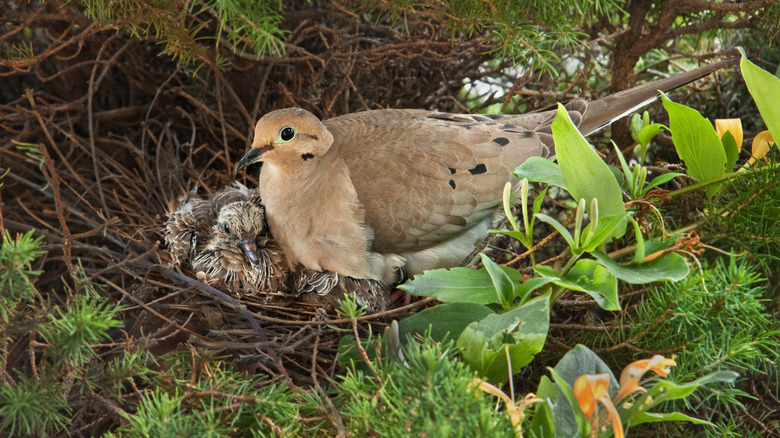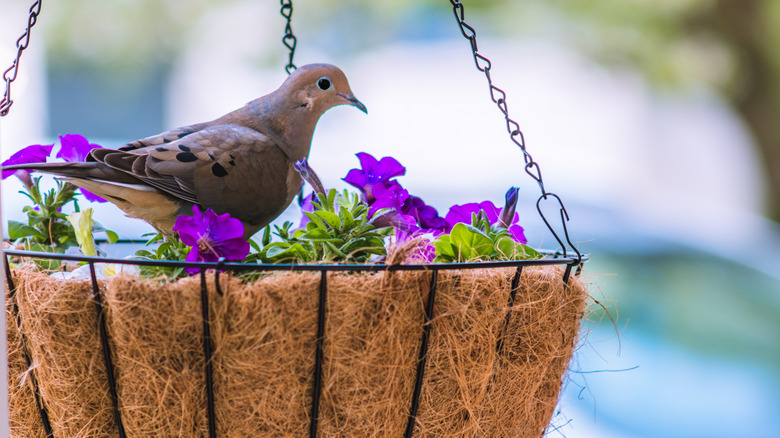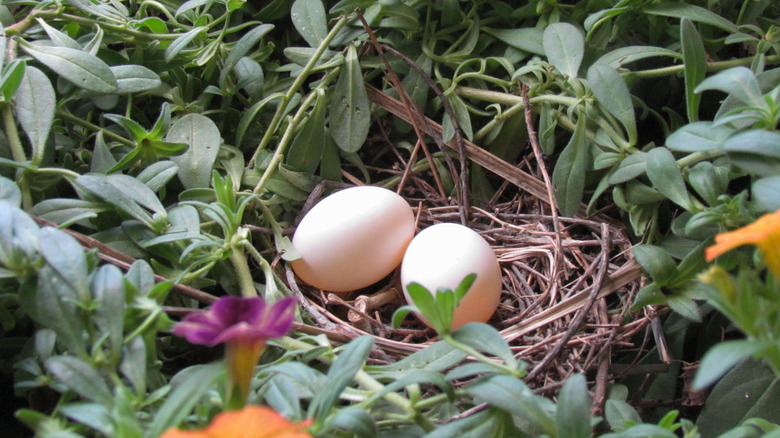Encourage Mourning Doves To Nest In Your Yard With This Easy DIY
If birds' nests were rated like vacation rentals, mourning doves' austere accommodations and crude construction would earn plenty of one-star reviews. While other birds spend days or weeks stitching grasses and spiderwebs into elaborate dwellings, mourning doves toss a few twigs in a rain gutter and call it a day. But they're building behavior is more calculating than careless. By spending less time on construction, they can nest as many as six times per year and maximize the chances that at least some of their offspring will survive. This hastiness, however, leads to some baffling location choices. It's not unusual to find mourning dove nests precariously perched on the rung of a ladder, nestled inside an empty pot, or tucked atop a ceiling fan.
Despite their lackadaisical approach to nest building, mourning doves are very attentive parents, and watching them raise their young is rewarding. Attracting mourning doves to your yard is simple enough, but you'll need some special amenities if you want them to nest there. Mourning doves won't use traditional birdhouses or nest boxes, but they appreciate simple DIY nesting baskets. All you need is some ¼-inch metal hardware cloth, tin snips, and either galvanized steel wire or zip ties.
How to make a mourning dove nesting basket
To construct the nest basket, cut the hardware cloth into a 12-by-12-inch square. Hardware cloth is very sharp, so wear gloves and safety glasses. Next, trim the square to form a circle, and then cut out a pie-shaped wedge (imagine cutting a slice of pie). The outer rim of the wedge should be about 2 inches wide. Form a cone by pulling the two cut edges toward each other until they overlap by about 1 inch. Secure the edges together using zip ties or steel wire. Be sure to fold back the sharp edges of the cone.
Using wire, heavy-duty staples, or zip ties, attach the nest basket to a forked tree branch about 6-10 feet off the ground. Find a location where the nest will be partially shaded and hidden by vegetation — but still accessible enough that the doves can easily enter and exit. When fledglings leave the nest, they spend a few days on the ground until they master their flying skills, so a location with nearby shrubs or other safe havens for birds is ideal.
What to do if they nest in your yard
If you're lucky enough to have doves build a nest in your yard, you can expect the entire nesting cycle to last about 30 days. The female lays two eggs, usually a day or two apart. Both parents take turns incubating the eggs and feeding the babies. Usually, the male stays on the nest during day and the female takes over at night. Young leave the nest around 14 days, but they often hang out nearby for another week or two while mom and dad continue to feed them.
While you might be tempted to put food out for your nesting doves, feeding them may cause more harm than good. Doves normally search for food far away from their nests, so you don't really need to supplement their diet. Plus, bird seed attracts predators like squirrels and egg-eating birds. A study in the International Journal of Avian Science found that placing feeders near nests makes them nearly five times more likely to be attacked by predators. If you're really worried about the birds getting enough food, place a feeder (make sure it's the best type for doves) as far away from the nest as possible.
Mourning doves sometimes return to previous nesting spots in subsequent years, so you may have repeat visitors. While their nests will never earn five-star reviews, you can make their accommodations sturdier and safer by providing simple baskets. Safer nests mean more babies survive and more doves to enjoy for years to come.


